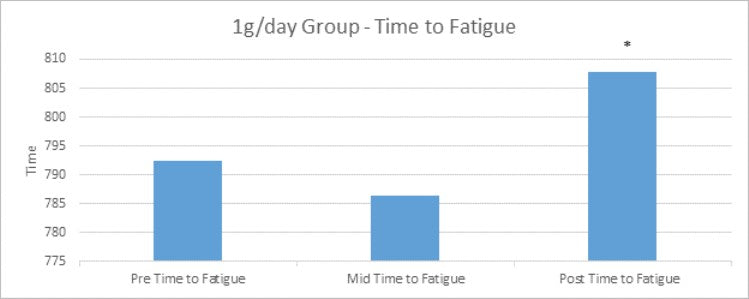Peak O2 made some waves this year. New data shows how to dose this breakthrough ingredient, and how to make it work best for you.
The first study reveals strong results using 4 grams of Peak O2 per day.
[1] This research was performed at the University of South Carolina. An eleven times increase in
VO2 Max - among other things - was established.
But we knew this compound had a build-up (systemic) effect in the body, much like creatine loading. The question is, what is the amount of time to reach full saturation based on dosing?
 Click here to order Peak Physicor with Peak O2 now.
Click here to order Peak Physicor with Peak O2 now.
Completed at the University of Charleston, the protocols were designed using standard athlete training methods. In other words, no test subject is going full speed, max-effort at all times for an entire exercise bout. The group's setup was:
- 1g Peak O2 per day for 28 days
- 2g Peak O2 per day for 28 days
- 12g Peak O2 per day for 7 days
Changes with 1g/day for 28 days:
- Significant improvement (4.2%) in time to fatigue from pre-to-post (+22.6 sec)
- Significant 3.3% improvement in Economy VO2 (this is the VO2 during a sub-max 5-minute steady state cycle). (23.04 ± 3.0 ml/kg/min-1) to post (22.3 ± 3.0 ml/kg/min-1)
- Significant improvement in HR Recovery from pre-to mid (reduction of 4.2 bpm)

*Indicates difference from baseline at p<.05>
This graph shows the time to fatigue measured during the aerobic capacity test in the group receiving 1g/day of PeakO2. We have a pre (baseline), mid (14 days), and post (28 days) measurement.

*Indicates difference from baseline at p<.05>
This graph is showing the VO2 measured during the economy phase of the Aerobic Capacity test in the group receiving 1g of PeakO2 per day. This is a five minute, sub-maximal stage, that is the same intensity across testing.
We have a pre (baseline), mid (14 day), and post (28 day) measurement. VO2 max is significantly lower.
Changes with 2g/day for 28 days:
- Trend (p=.06) for improvement (3.6%) in time to fatigue from pre-to post (+28.9 sec)
- Significant reduction in Economy lactate (this is the blood lactate sampled during a sub-max 5-minute steady state cycle) from pre (2.4 ± 0.6 mmol/L) to mid (2.3 ± 0.6 mmol/L) and from pre to post (2.2 ± 0.5 mmol/L)

*Indicates trend for difference from baseline
This graph shows the time to fatigue measured during the
aerobic capacity test in the group receiving 2g/day of PeakO2. We have a pre (baseline), mid (14 day), and post (28 day) measurement.
Time to fatigue indicates a strong trend (p=.06) exists for an increase in the 2g/day group. This represents 9 subjects in the 2 g/day group.

*Indicates difference from baseline at p<.05>This graph is showing the lactate taken during the economy phase of the aerobic capacity test in the group receiving 2g of PeakO2 per day. We have a pre (baseline), mid (14 days), and post (28 days) measurement.
This is a five minute, sub-maximal stage, that is the same intensity across testing. Lactate is significantly lower.
Changes with 12g/day for 7 days. Changes in bottom 50% of treatment group:
- Significant increase (p=.02) in VO2max (36.9 ± 3.8 to 38.9 ± 4.4 ml/kg/min-1)
- Significant 2.6 % increase in absolute peak power output from pre-to post
- Significant increase 6.3% in relative peak power from pre-to post
Seven days of supplementation with 12.0 g/day of PeakO2 may improve aerobic and anaerobic power output in less aerobically fit, healthy individuals.
Changes in the top 50% of treatment group:
- Significant 23.2-second increase (2.8%) in time to fatigue
- A significant drop (3.5 bpm) in economy HR from pre-to post-test.
Those higher fitness level, apparently healthy individuals may see an improvement (e.g lower Heart Rate) in the economy during sub-maximal aerobic exercise. Meaning they can do more work with less effort.
*** These are unpublished data from an ongoing study and results may change as the study progresses.
In all groups, they noticed extremely positive results for both power and endurance. The data shows Peak O2 helps you perform more work with less effort. They also demonstrated statistically positive effects for explosive movements (lifting heavy weights!), as well as aerobic exercise greater than 10 seconds. In other words, it helps with all aspects of performance.
The take-home message is that you want to get to 28g TOTAL and maintain it. This is why Peak Physicor recommends never cycling off. It helps you get to where you need to be and then 1g maintains it so
never cycle off of Peak Physicor. Thus take 1g per day for 28 days, then keep taking 1g indefinitely. There is no reason to cycle off. Peak Physicor delivers 1g PeakO2 per day.
PeakO2 is a blend of six organic-certified adaptogens which are whole foods. They are not extracts. There is no reason NOT to supplement with this ingredient, and you can find it in Peak Physicor.
References
1) "Cordyceps Militaris Improves Tolerance to High-Intensity Exercise After Acute and Chronic Supplementation: Journal of Dietary Supplements: Vol 14, No 1." Taylor & Francis Online, www.tandfonline.com/doi/full/10.1080/19390211.2016.1203386.

 Click here to order Peak Physicor with Peak O2 now.
Click here to order Peak Physicor with Peak O2 now.


